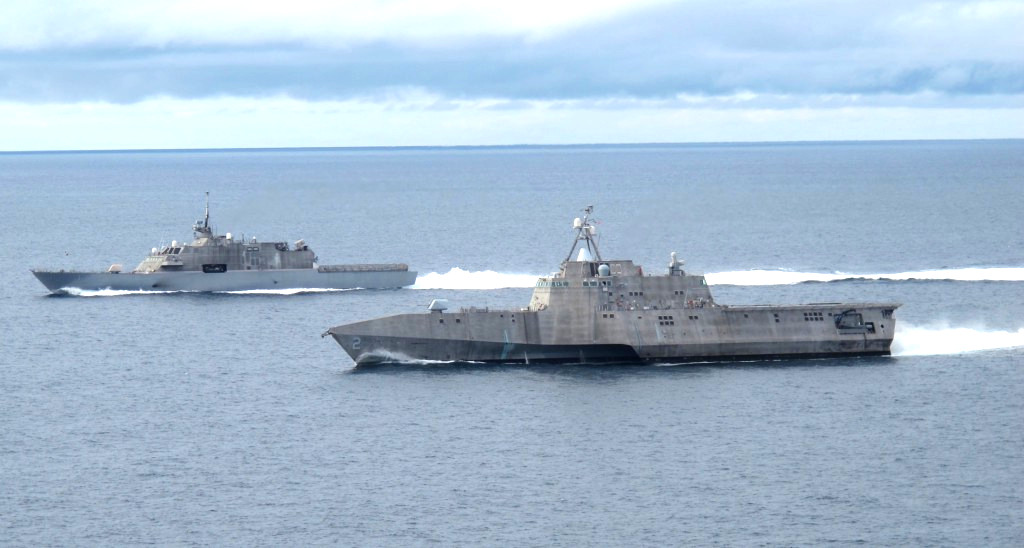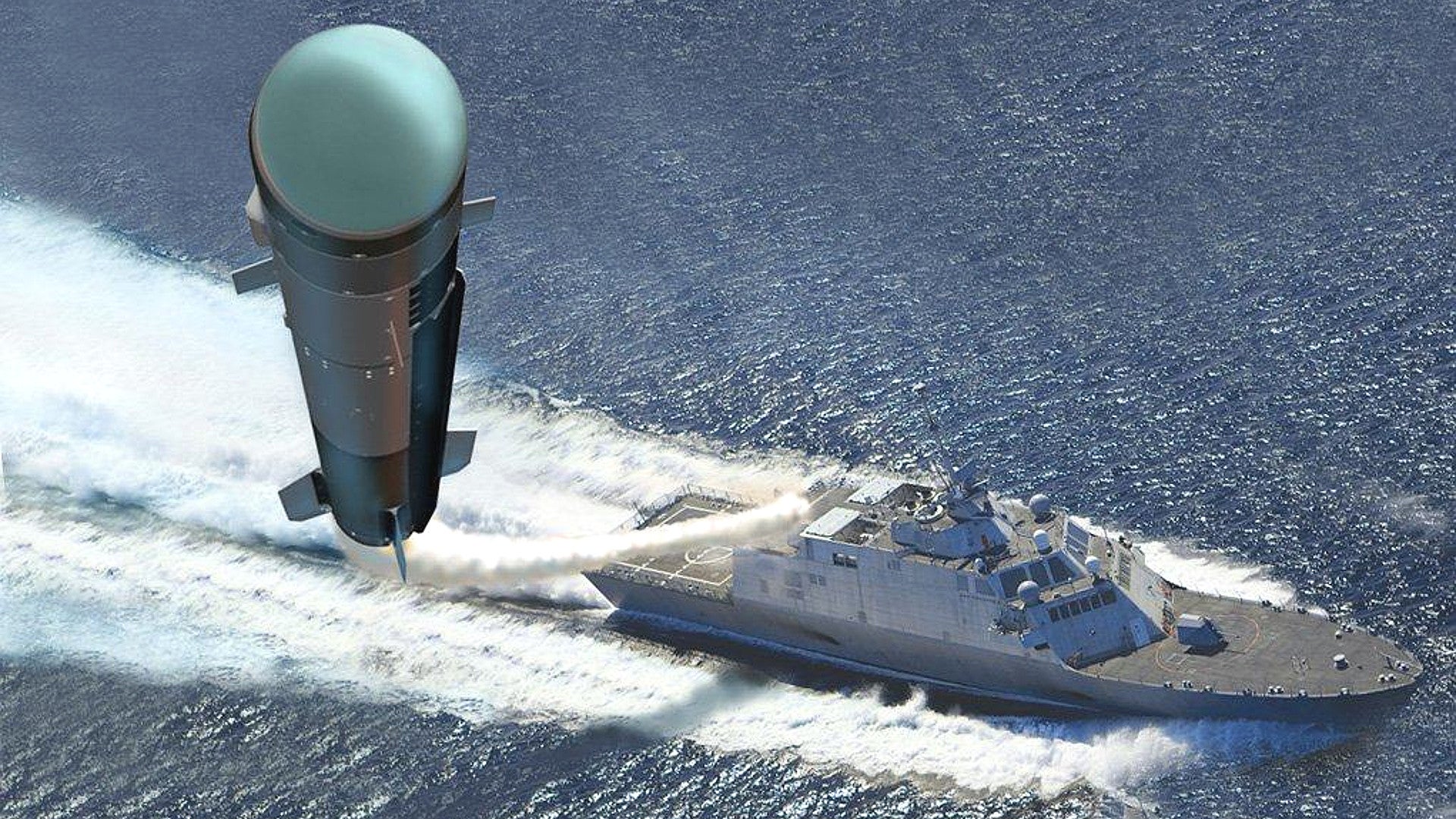More than a year after the Freedom-class Littoral Combat Ship USS Detroit
first test fired an AGM-114L Longbow Hellfire, the U.S. Navy still hasn’t officially decided whether or not to proceed with production of the complete Surface-to-Surface Missile Module, or SSMM, for the rest of the ships. But without the missiles, the ships will have even more limited utility in actual combat situations, criticisms that have already prompted the service to start an all-new frigate project.
In February 2018, the Navy gave members of Congress these details in an update on the SSMM’s progress, Seapower magazine reported. The service has been working to integrate Hellfire into the module, which is part of the larger Surface Warfare Mission Package for both Freedom– and Independence-class LCS, since 2014. The full package also includes a pair of 30mm Bushmaster II cannons and the ability to launch an MH-60R Sea Hawk helicopter, two MQ-8 Fire Scout drones, and a pair of small Rigid Hull Inflatable Boats, or RHIBs.
The Hellfire component “is currently in testing and exceeding requirements,” the report said, according to Seapower. “To date, the SSMM has achieved an 83 percent successful engagement rate.”
As of the date of the report to lawmakers, there had been 24 test launchers as part of developmental testing. The Navy said that four of those failed due to unspecified software problems, but it is not clear whether that refers to the SSMM’s fire control systems or the software internal to the AGM-114L. Regardless, the Navy said it had successfully fixed those issues.

At present, the USS Milwaukee, another Freedom-class LCS, is carrying the prototype vertical launch system and fire control components. Since that Navy is planning to send that ship out on an operational deployment later in 2018, the service plans to reinstall the weapons on USS Detroit in July 2018 to continue the developmental work.
If this process and the subsequent tests go as planned, the Navy hopes to finish the SSMM’s development by the beginning of the 2019 fiscal year, which starts on Oct. 1, 2018. With any luck, operational test and evaluation will be done by the end of 2018, at which time the service will make a final, formal decision about how to proceed.

The existing goal is for the system will begin entering service on a deployed LCS in early 2019. “The addition of the SSMM will make LCS with an embarked [surface warfare mission package] the most capable ship in the Navy in countering the small-boat threat,” the report said.
The AGM-114L Hellfire should be more than capable of handling those types of threats and would significantly improve the two LCS classes’ abilities to defend themselves in constrained, littoral areas where they are supposed to operate. It also might make the ships capable of acting as a picket against those threats for larger naval surface task forces or carrier strike groups.
With a millimeter wave radar seeker, each missile has an all-weather fire-and-forget capability. The fire control system can either cue the missiles with a radar on the ship or the missiles can lock on after launch having used own internal inertial guidance system to bring close to the target. This combination of capabilities would give the crew on the LCS the option of targeting multiple small boats in a swarm and firing a barrage of missiles to attack them all.

With this in mind, it seems hard to imagine the Navy wouldn’t decide to pursue the SSMM when testing wraps up and there do not appear to be any serious developmental issues to hold up that process. More importantly, without the weapons, the service would be unlikely to get as much value out of the ships at all.
It’s worth noting that the Hellfires are a replacement for a far more capable concept based on the U.S. Army’s XM501 Non-Line Of Sight (NLOS) system. The AGM-114L vertical launch array fits into the empty space on both classes of LCS that was supposed to have held these weapons.
The XM501 launchers were supposed to be able to fire different flavors of missile, a standard strike version with a range of 30 miles and a quasi-drone loitering model that could stay aloft for up to 30 minutes before dropping on a target. The AGM-114L has a range of around five miles, but this could be less for shipboard systems due to being vertically launched and having no altitude advantage.

When the Army cancelled that program in 2011, fallout from the decision to cancel the larger and ambitious Future Combat Systems project two years earlier, the Navy initially decided not to pursue a replacement of any kind. Three years later it bowed to pressure and chose a vertical launch system capable of firing the well established Hellfire, but which offered significantly limited capabilities.
That’s not to say the threat of swarming fast attack craft or even small manned or unmanned suicide boats isn’t real. Far from it and without the SSMM both classes of LCS have been conspicuously absent from operations in parts of the world where this threat is most pronounced, particularly the Strait of Hormuz leading in and out of the Persian Gulf and the Mandeb Strait that links the Red Sea with the Gulf of Aden.
The video below shows a test of the Longbow Hellfire vertical launch system from a test ship rather than an LCS in 2015 with simulated small enemy boats as the targets.

But even with the new missiles, part of patchwork of add-on capabilities the Navy has tried to stitch together on the perpetually underperforming ships over the years, the LCS will remain of limited utility in even mid-level threat environments and largely incapable of operating independently in an actual combat scenario. As it stands now, the ships’ only other on board weapons are a 57mm rapid fire gun and a RIM-116 Rolling Airframe Missile close-in protection system. There are also plans to add an over-the-horizon anti-ship missile capability in the future and the Independence-class USS Coronado has demonstrated the ability to launch RGM-84 Harpoons.
The Navy might conceivably decide the resources it is spending on the Hellfire capability could be better utilized on other pressing projects. The service might also come to the conclusion it makes more sense to focus entirely on the new frigate program, which will almost certainly produce more capable ships.
This seems unlikely, though, since abandoning the SSMM would be yet another admission that the LCS as a concept has failed to live up to the hype. It would also effectively relegate the existing examples entirely to second-line duties, such as counter drug patrols, something the service seems disinclined to do with any such ship for any reason.

With more than two dozen of the ships in service or on order, and shipyards worried about maintaining their production capacity even at the present rate, it’s hard to imagine that Navy would choose this route or be able to convince Congress to approve the plans. In the meantime, the service seems determined to try and squeeze as much capability out of the Freedom– and Independence-classes as it can, at least until the new frigates arrive.
That being said, it seems increasingly apparent, unfortunately, that the LCS are unlikely to ever reach the level of capability the Navy desires, as is evidenced by the requirements it has set out in the frigate program. So, while it seems very likely that the Navy will follow through with adding Hellfires to the ships, the emphasis on future upgrades to the ships’ firepower or other systems may steadily decrease.
At a certain point, no amount of bolted on components will be able to truly make up the inherent limitations of both classes.
Contact the author: jtrevithickpr@gmail.com
